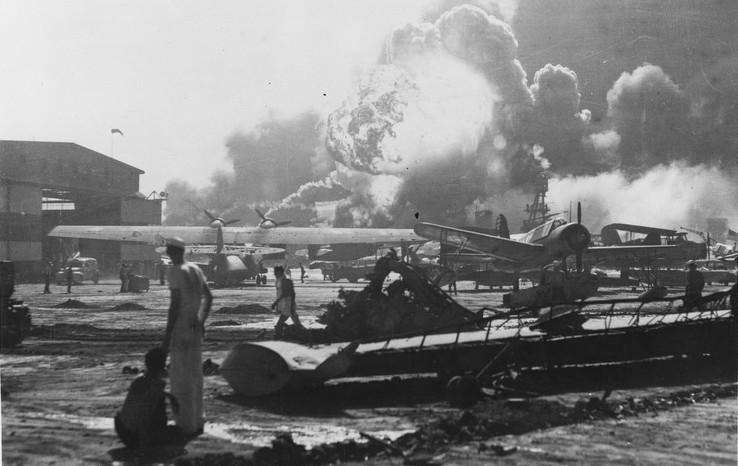Last year, we put our research team here to work in an effort to uncover Ten Little-Known Facts About the Attack on Pearl Harbor. Needless to say, we overshot our target. What started as a project to mark the 80th anniversary of that pivotal moment in US history, soon turned into a surplus of captivating factual information that the average American may be completely unaware of. So on the 81st anniversary of the devastating attack, we bring you 10 more additional facts sure to pique your interest and impress your friends.
1. The Japanese military dispatched several foreign spies to Hawaii.
In the time leading up to the attack, the Japanese Military employed foreign spies to various levels of success on the main island. One of which was Otto Kuhn, a German sleeper agent who set up residence in Hawaii in 1935 and was contracted to collect intel on behalf of the Japanese. Aided by his wife and children, Kuhn compiled espionage reports that were deemed insufficient by Japanese handlers and quickly dismissed. He and his family were eventually deported back to Germany just weeks after the attack in January of 1942.
Another spy named Takeo Yoshikawa posed as a junior diplomat at the Japanese consulate in Honolulu and ultimately played a bigger role in the attack. Detailing US naval activity, Yoshikawa relayed several messages back to Japan that was eventually intercepted and deciphered after the attack. The last of which detailed the positioning of US warships around the harbor.
2. Japan codenamed the attack “Operation Z”.
Referencing the Z flag, an international sign for the letter ‘Z’ at sea and a symbol of victory in Japan, the codename was intended to represent an imminent victory. For the Japanese Imperial Navy, claiming Pearl Harbor would in their minds, ensure victory against the Americans.
3. The attack on Pearl Harbor was meant to be the first step.
Never meant to serve as the ultimate end goal, Pearl Harbor was intended to serve as the first domino to fall in Japan’s attempt to secure what they called the Southern Resource Area. Delivering such a hit to the US Navy would ideally leave the rest of the area vulnerable, and allow a full invasion of the Philippines where further US naval and air bases would be susceptible to attack.
4. The American forces were already on alert at the time of the attack.
Although much has been written about it being a surprise strike, the fact is that American officials were fully aware that war could break out at a moment’s notice. However, they believed that the Phillippines was the primary target and that Pearl Harbor was more at risk for sabotage.
5. The USS Arizona’s band perished in the attack.
Rising early to prepare music for the daily flag raising ceremony, all 21 members of the US Navy Band Unit (NBU) 22 were aboard when the battleship was hit four times by Japanese bombers and eventually sunk. At the time of the attack, each member manuevered to their battle positions under the Arizona’s gun turret. This is the only reported instance in American history where an entire military band died in action.
6. Roosevelt nearly left the word “infamy”out of his speech.
Immortalized in film and military lore, the line “A date which will live in infamy” was orginally written as “A date which will live in world history” before President Franklin D. Roosevelt personally rewrote the line. The rest was history.
7. The USS Oklahoma went belly up.
Of the eight Pearl Harbor battleships that were attacked, only the USS Arizona and the USS Oklahoma proved to be unsalvageable. The latter of which was torpedoed relentlessly by Japanese forces, eventually having its hull compromised and capsizing in the harbor resulting in the deaths of 429 crew members.
8. The attack could have been even worse.
With a direct objective to target the battleships due to the incorrect belief that they were carrying a majority of the fleet, the Japanese left the Navy repair yards, oil tank farms, submarine bases, and old headquarters building completely untouched. This allowed the Americans to rebuild quickly and salvage a majority of the battleships.
9. A fictional book inspired the Japanese war plan.
Japanese Admiral Isoroku Yamamoto spearheaded the attack on Pearl Harbor, and was partially inspired by The Great Pacific War, a book written in 1925 by Hector Bywater, a British naval authority. The book detailed the realistic account of a battle between the United States and Japan, highlighted by the Japanese destruction of the US fleet.
10. Elvis Presley Helped Raise Cash for USS Arizona Memorial
The hound dog helps out. On March 25th, 1961, the legendary singer performed a benefit concert that raised over $54,000 for the memorial, in addition to making a separate donation himself. Endorsed by his manager, Col. Tom Parker, Presley was advised that such a concert would create positive publicity. A former Army veteran himself, Presley’s fame brought continual attention to the memorial fund, generating even more money from the public and private sectors.

